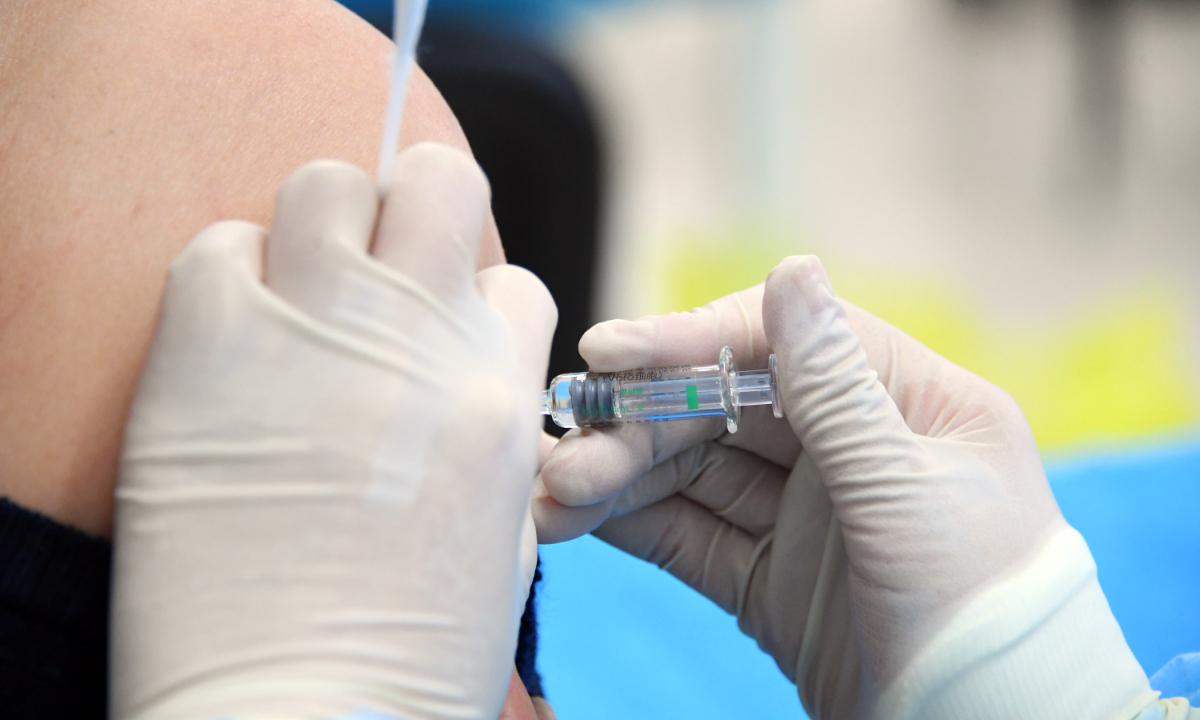China's new COVID-19 control protocol stresses regular monitoring of mutated variants, boosting vaccination among elderly

A medical worker inoculates a recipient with a COVID-19 vaccine at a temporary inoculation site in Haidian District in Beijing, capital of China, Jan. 11, 2021.(Photo: Xinhua)
The State Council joint prevention and control mechanism against COVID-19 issued the 10th edition of the COVID-19 prevention and control protocol on Saturday in accordance to the decision of downgrading the epidemic management from Class A to Class B, highlighting the monitoring of mutated variants and early warning as well as protection of key groups by preventing severe cases.
The new version of epidemic prevention and control plan advocates increased vaccination and self-protection, calling for enhancing the monitoring of new variants and use of the national influenza surveillance network .
Based on the national influenza surveillance network, 554 national influenza surveillance sentinel hospitals are required to carry out influenza-like illness (ILI) and severe acute respiratory infections (SARI) surveillance.
In tracing the virus mutation, the updated version requires the collection of samples from outpatient and emergency cases, severe cases and deaths in sentinel hospitals in representative cities, as well as among entry personnel at land, air and sea ports to carry out whole-genome sequencing and report them to the Chinese Center for Disease Control and Prevention's Institute of Virology in order to capture new mutant strains in a timely manner.
It also requires localities to select qualified cities to carry out monitoring of the coronavirus in urban sewage, which could help evaluate the epidemic intensity and understand the changing trend and virus mutation.
Medical institutions at all levels should report new COVID infections within 24 hours to the direct online reporting system operated by the China CDC, according to the new version of the protocol. The previous version of the epidemic prevention and control protocol required reporting of new cases within two hours.
For severe, critical cases and deaths, disease control departments should carry out epidemiological investigations in a timely manner and upload relevant reports as required.
The updated version also advocates for boosting vaccination, especially among elderly people who should ideally receive two doses and booster shots.
For people at high risk of infection, those over 60 years old, and those with serious underlying diseases and low levels of immunity, the second dose of booster can be delivered six months after completing the first dose of booster shot, the protocol said.
It also requires to increase the full vaccination rate and booster immunization rate for severe and high-risk groups such as the elderly aged 60 and over.
The new protocol also defines an updated testing strategy, in which mass testing in communities will be scrapped, while sufficient testing capacity for residents who are willing to take nucleic acid testing in line with their own willingness will be maintained.
There will be no more mandatory quarantine measures and no tracing of close contact or designation of high and low risk areas. Those infected with coronavirus but with mild symptoms can opt for home quarantine.
As part of regular epidemic prevention and control, emergency prevention measures will no longer be required. But if the epidemic situation deteriorates, and in consideration of virus variation, the intensity of the outbreak and medical resources and social impact, authorities can take temporary measures by reducing movement and ease the pressure on the social and medical resources.
Those measures include temporarily suspending large-scale activities such as exhibitions, game and performance. Public places such as museums and art museums can adopt restrictions on visitors' flow and companies and factories can adopt "work-at-home" measures. Schools and kindergartens may also shift to online classes.
The management of COVID-19 will be downgraded from Class A to Class B from Sunday, January 8, which was a decision made after China's COVID-19 prevention and control entered a new stage as the virulence of the virus weakened, and the majority of the population has been inoculated with COVID-19 vaccines. It also represents that the country's anti-epidemic strategy has shifted from preventing infection to treatment.
The latest protocol was issued after China on Friday released the 10th edition of its diagnosis and treatment protocol for novel coronavirus infection, adding antigen results as diagnostic criteria.
"Those adjustments are in line with our overall epidemic prevention and control strategy shift, which means no more stringent management as we have decided to downgraded COVID management and shifted the focus from prevention to medical treatment and prevention of severe illness," an expert close to the China CDC who spoke on the condition of anonymity told the Global Times on Saturday.
"Also, the ninth edition of the COVID-19 prevention and control protocol required medical institutions to report new infections within two hours but now the requirement extends to 24 hours, which will help medical institutions to report numbers more effectively, reflecting the true epidemic situation," he said.
The State Council joint prevention and control mechanism also issued the new guidelines for COVID prevention and control in accordance to the management requirement for a Class B infectious disease. The 83-page guidelines include four chapters covering general epidemic prevention work, medical treatment, epidemic prevention and control in key places and among key groups.
The guidelines require hospitals to enhance medical resources for treating severe cases by accelerating and upgrading ICU units to ensure that the number of comprehensive ICU beds used for the treatment of various critically ill patients infected with COVID-19 is no less than 4 percent of the total number of beds actually opened in the hospital.
Hospitals are also required to reserve an area of beds that could be transferred to ICU beds within 24 hours, which should not be less than 4 percent of the total beds opened. ICU beds in designated hospitals for treating COVID infections should not be less than 10 percent of the total beds, the guidelines state. Fangcang makeshift hospitals across the country will be upgraded into sub-designated hospitals and reserve 10 percent of their total beds into beds used for medical surveillance.
The new guidelines also detailed epidemic prevention and control in different scenarios such as shopping malls, supermarkets, farm markets, restaurants and exhibition activities.



